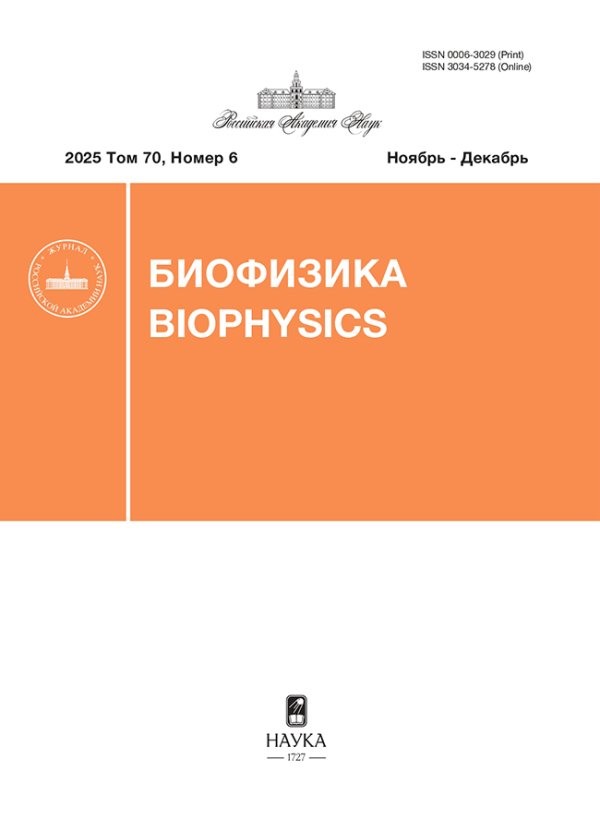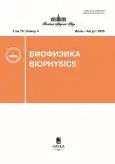Oxygenic Photosynthesis in silico: Ferredoxin and Alternative Electronic Transport Pathways
- Authors: Vershubskii A.V1, Tikhonov A.N1
-
Affiliations:
- Department of Physics, Lomonosov Moscow State University
- Issue: Vol 70, No 4 (2025)
- Pages: 652–663
- Section: Cell biophysics
- URL: https://bakhtiniada.ru/0006-3029/article/view/306890
- DOI: https://doi.org/10.31857/S0006302925040031
- EDN: https://elibrary.ru/LJRWED
- ID: 306890
Cite item
Abstract
About the authors
A. V Vershubskii
Department of Physics, Lomonosov Moscow State UniversityMoscow, Russia
A. N Tikhonov
Department of Physics, Lomonosov Moscow State University
Email: an_tikhonov@mail.ru
Moscow, Russia
References
- Эдвардс Д. и Уокер Д. Фотосинтез С3и С4-растений: механизмы и регуляция (Мир, М., 1986).
- Blankenship R. E. Molecular Mechanisms of Photosynthesis (Blackwell Science Inc., Malden, MA, 2002).
- Buckanan B. B. Role of light in the regulation of chloroplast enzymes. Ann. Rev. Plant Physiol., 31, 341–374 (1980).
- Andersson I. Catalysis and regulation in Rubisco. J. Exp. Bot., 59, 1555–1568 (2008).
- Strand D. D., Fisher N., and Kramer D. M. Distinct energetics and regulatory functions of the two major cyclic electron flow pathways in chloroplasts. In: Chloroplasts: Current research and future trends, Ed. by H. Kirchhoff (Caister Acad. Press, Norfolk, UK, 2016), pp. 89–100.
- Shikanai T. and Yamamoto H. Contribution of cyclic and pseudo-cyclic electron transport to the formation of proton motive force in chloroplasts. Mol. Plant.,10 (1), 20–29 (2017).
- Tikhonov A. N. The cytochrome b6 f complex: Biophysical aspects of its functioning in chloroplasts. In: Membrane protein complexes: Structure and function. Subcellular biochemistry, Ed. by J. R. Harris and E. J. Boekema (Springer, Singapore, 2018), vol. 87, pp. 287–328.doi: 10.1007/978-981-10-7757-9_10
- Anderson J. M. Distribution of the cytochromes of spinach chloroplasts between the appressed membranes of grana stacks and stroma-exposed thylakoid regions. FEBS Lett., 138 (1), 62–66 (1982).
- Lemeille S. and Rochaix J.-D. State transitions at the crossroad of thylakoid signaling pathways. Photosynth. Res., 106, 33–46 (2010).
- Puthiyaveetil S., Kirchhoff H., and Huhner R. Structural and functional dynamics of the thylakoid membrane system. In: Chloroplasts: current research and future trends, Ed. by H. Kirchhoff (Caister Acad. Press, Norfolk, UK, 2016), pp. 59–87.
- Kirchhoff H., Hall C., Wood M., Herbstová M., Tsabari O., Nevo R., Charuvi D., Shimoni E., and Reich Z. Dynamic control of protein diffusion within the granal thylakoid lumen. Proc. Natl. Acad. Sci. USA, 108, 20248–20253 (2011).
- Horton P. Optimization of light harvesting and photoprotection: molecular mechanisms and physiological consequences. Phil. Trans. Roy. Soc. B: Biol. Scie., 367 (1608), 3455–3465 (2012).
- Hepworth C., Wood W. H., Emrich-Mills T. Z., Proctor M. S., Casson S., and Johnson M. P. Dynamic thylakoid stacking and state transitions work synergistically to avoid acceptor-side limitation of photosystem I. Nat. Plants, 7, 87–98 (2021).doi: 10.1038/s41477-020-00828-3
- Tagawa K. and Arnon D. I. Ferredoxins as electron carriers in photosynthesis and in the biological production and consumption of hydrogen gas. Nature, 195, 537−543 (1962).
- Balsera M., Schürman P., and Buchanan B. B. Redox regulation in chloroplasts. In: Chloroplasts: Current Research and Future Trends, Ed. by H. Kirchhoff (Caister Acad. Press, Norfolk, UK, 2016), pp. 187–207.
- Nikkanen L. and Rintamäki E. Chloroplast thioredoxin systems dynamically regulate photosynthesis in plants. Biochem. J., 476, 1159–1172 (2019).
- Noguchi K. and Yoshida K. Interaction between photosynthesis and respiration in illuminated leaves. Mitochondrion, 8, 87–99 (2008).
- Asada K. The water-water cycle in chloroplasts. Scavenging of active oxygens and dissipation of excess photons. Ann. Rev. Plant Physiol. Plant Mol. Biol., 50 (1), 601–639 (1999).
- Foyer C. H. and Noctor G. Oxygen processing in photosynthesis: regulation and signalling. New Phytol., 146, 359–388 (2000).
- Козулева М. А. и Иванов Б. Н. Генерация супероксидного анион-радикала в фотосинтетической электрон-транспортной цепи. Биохимия, 88 (8), 1283– 1301 ( 2023).
- Photosynthesis in silico: Understanding Complexity from Molecules to Ecosystems., Ed. by A. Laisk, L. Nedbal, and Govindjee (Springer, Dordrecht, 2009).
- Rubin A. and Riznichenko G. Mathematical Biophysics (Springer, N.Y., 2014).
- Tikhonov A. N. and Vershubskii A. V. Computer modeling of electron and proton transport in chloroplasts. Biosystems, 121, 1–21 (2014).
- Вершубский А. В., Приклонский В. И. и Тихонов А. Н. Математическое моделирование электронного и протонного транспорта, сопряженного с синтезом ATP в хлоропластах. Биофизика, 49, 57–71 (2004).
- Vershubskii A. V., Kuvykin I. V., Priklonsky V. I., and Tikhonov A. N. Functional and topological aspects of pHdependent regulation of electron and proton transport in chloroplasts in silico. Biosystems, 103, 164–179 (2011).
- Вершубский А. В. и Тихонов А. Н. Электронный транспорт и трансмембранный перенос протонов в фотосинтетических системах оксигенного типа in silico. Биофизика, 58 (1), 75–89 (2013).
- Вершубский А. В., Мишанин В. И. и Тихонов А. Н. Моделирование регуляции фотосинтетического транспорта электронов у цианобактерий. Биол. мембраны, 31 (2), 110–128 (2014).
- Вершубский А. В., Невьянцев С. М. и Тихонов А. Н. Моделирование электронного и протонного транспорта в мембранах хлоропластов с учетом тиоредоксин-зависимой активации цикла Кальвина−Бенсона и ATP-синтазы. Биол. мембраны, 35 (2), 87–103 (2018).
- Вершубский А. В. и Тихонов А. Н. рН-зависимая регуляция электронного и протонного транспорта в хлоропластах in situ и in silico. Биол. мембраны, 36 (4), 242–254 (2019).
- Вершубский А. В., Приклонский В. И. и Тихонов А. Н. Оксигенный фотосинтез: индукция флуоресценции хлорофилла a и регуляция электронного транспорта в тилакоидных мембранах in silico. Биол. мембраны, 42 (1), 3–19 (2025).
- Караваев В. А. и Кукушкин А. К. Исследование состояния электронно-транспортной цепи в листьях высших растений методом быстрой индукции флуоресценции. Биофизика, 21 (5), 862–866 (1976).
- Stirbet A., Govindjee, Strasser B., and Strasser R. J. Chlorophyll a fluorescence induction in higher plants: Modelling and numerical simulation. J. Theor. Biol., 193, 131– 151 (1998).
- Kramer D. M., Sacksteder C. A., and Cruz J. A. How acidic is the lumen? Photosynth. Res., 60, 151–163 (1999).
- Johnson M. P. and Ruban A. V. Rethinking the existence of a steady state ∆ψ component of the proton motive force across plant thylakoid membranes. Photosynth. Res., 60, 151–163 (2014).
- Wilson S., Johnson M. P., and Ruban A. V. Proton motive force in plant photosynthesis dominated by ∆pH in both low and high light. Plant Physiol., 187, 263–275 (2021).
- Физиология растений, Под ред. И. П. Ермакова (Академия, М., 2007).
- Рууге Э. К. и Тихонов А. Н. Электронный парамагнитный резонанс: исследование механизмов регуляции световых стадий фотосинтеза растений. Биофизика, 67 (3), 516–523 (2022).
- Suslichenko I. S., Trubitsin B. V., Vershubskii A. V., and Tikhonov A. N. The noninvasive monitoring of the redox status of photosynthetic electron transport in Hibiscus rosa-sinensis and Tradescantia leaves. Plant Physiol. Biochem., 185, 233–243 (2022).
- Беньков М. А., Сусличенко И. С., Трубицин Б. В. и Тихонов А. Н. Влияние акклимации растений на электронный транспорта в мембранах хлоропластов Cucumis sativus и Cucumis melo. Биол. мембраны, 40 (3), 172–187 (2023).
- Маринин Н. А., Сусличенко И. С. и Тихонов А.Н. Регуляция электронного транспорта в хлоропластах; индукционные процессы в листьях растений рода Cucumis. Биофизика, 70 (1), 59–71 (2025).
- Gross E. L. Plastocyanin: structure and function. Photosynth. Res., 37, 103–116 (1993).
- Trinh M. D. K. and Masuda S. Chloroplast pH regulation homeostasis for the regulation of photosynthesis. Front. Plant Sci., 13, 919896 (2022).
- Tikhonov A. N. pH-Dependent regulation of electron transport and ATP synthesis in chloroplasts. Photosynth. Res., 116, 511–534 (2013).
- Tikhonov A. N. Induction events and short-term regulation of electron transport in chloroplasts: an overview. Photosynth. Res., 125, 65–94 (2015).
- Mishanin V. I., Trubitsin B. V., Benkov M. A., Minin A. A., and Tikhonov A. N. Light acclimation of shade-tolerant and light-resistant Tradescantia species: induction of chlorophyll a fluorescence and P700 photooxidation, expression of PsbS and Lhcb1 proteins. Photosynth. Res., 130 (1–3), 275–291 (2016).
- Mishanin V. I., Trubitsin B. V., Patsaeva S. V., PtushenkoV. V., Solovchenko A. E., and Tikhonov A. N. Acclimation of shade-tolerant and light-resistant Tradescantia species to growth light: chlorophyll a fluorescence, electron transport, and xanthophyll content. Photosynth. Res., 133 (1–3), 87–102 (2017).
- Benkov M. A., Yatsenko A. M., and Tikhonov A. N. Light acclimation of shade-tolerant and sun-resistant Tradescantia species: photochemical activity of PSII and its sensitivity to heat treatment. Photosynth. Res., 139, 203–214 (2019).
- Ptushenko V. V., Zhigalova T. V., Avercheva O. V., and Tikhonov A. N. Three phases of energy-dependent induction of P700+ and Chl a fluorescence in Tradescantia fluminensis leaves. Photosynth. Res., 139, 509–522 (2019).
- Long S. P., Taylor S. H., Butges S. J., Carmo-Silva E., Lawson T., De Souza A. P., Leonelli L., and Wang Y. Into the shadow and back into sunlight: Photosynthesis in fluctuating light. Annu. Rev. Plant Biol., 73, 617–648 (2022).
- Hald S., Pribil M., Leister D., Gallois P., and Johnson G. N. Competition between linear and cyclic electron flow in plants deficient in Photosystem I. Biochim. Biophys. Acta, 1777, 1173–1183 (2008).
- Blanco N., Ceccoli R., Dalla Via M. V., Voss I., Segretin M. E., Bravo-Almonacid F. F., Melzer M., Hajirezaei M.-R., Scheibe R., and Hanke G. T. Expression of the minor isoform pea ferredoxin in tobacco alters photosynthetic electron partitioning and enhances cyclic electron flow. Plant Physiol., 161, 866–879 (2013).doi: 10.1104/pp.112.211078
- Hanke G. T. and Hase T. Variable photosynthetic roles of two leaf-type ferredoxins in Arabidopsis, as revealed by RNA interference. Photochem. Photobiol., 84, 1302–1309 (2008). doi: 10.1111/j.1751-1097.2008.00411.x
- Гинс В. К., Тихонов А. Н., Мухин Е. Н. и Рууге Э. К. Особенности функционирования двух молекулярных форм ферредоксина гороха в цепи электронного транспорта хлоропластов. Биохимия, 47 (11), 1859– 1866 (1982).
- Тихонов А. Н. Электронный транспорт в хлоропластах: регуляция и альтернативные пути переноса электронов. Биохимия, 88 (10), 1742–1760 (2023).
- Shapiguzov A., Vainonen J.P., Wrzaczek M., and Kangasjarvi J. ROS-talk how apoplast, the chloroplast, and the nucleus get a message through. Plant Sci., 3, 24–32 (2012).
- Demmig-Adams B., Cohu C. M., Muller O., and Adams W. W. Modulation of photosynthetic energy conversion efficiency in nature: from seconds to seasons. Photosynth. Res., 113, 75–88 (2012).
- Armbruster U., Correa Galvis V., Kunz H. H., and Strand D. D. The regulation of the chloroplast proton motive force plays a key role for photosynthesis in fluctuating light. Curr. Opin. Plant Biol., 37, 56–62 (2017).
- Foyer C. H., Neukermans J., Queval G., Noctor G., and Harbinson J. Photosynthetic control of electron transport and the regulation of gene expression. J. Exp. Bot., 63, 1637–1661 (2012).
- Khan I., Sohail, Zaman S., Li G., and Fu M. Adaptive response of plants to light stress: mechanisms of photoprotection and acclimation. A review. Front. Plant Sci., 16, 1550125 (2025).
- Lawson T. Guard cell photosynthesis and stomatal function. New Phytologist, 181, 13–34 (2009).
Supplementary files










